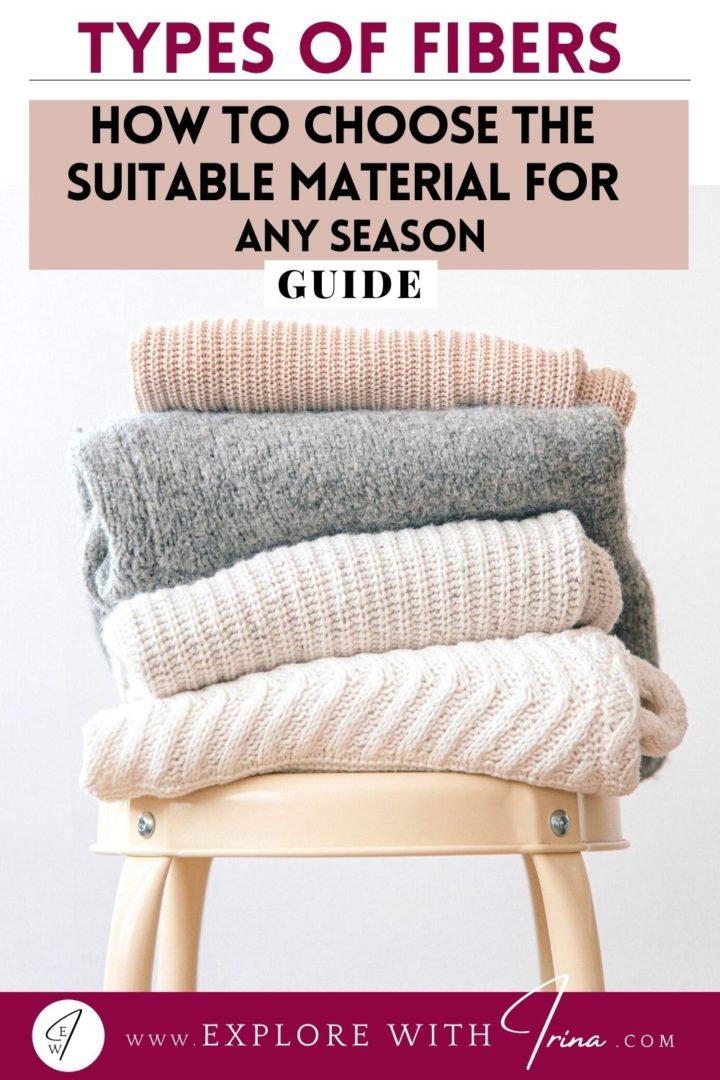Whether you are an ultimate fashionista or prefer clean and simple basic models, choosing the suitable material for a particular clothing piece is the key to success.
Knowing the difference between various fibers, their nature, and their characteristics will quickly help you build a perfect sustainable wardrobe for each season.
In this article, we shall discuss the difference between natural, synthetic materials, their blends, and varieties so you could make truly informed decisions for your sustainable wardrobe.
Fibers of the world
We usually distinguish between two types of fibers: Natural and Synthetic. However, this division is pretty rough.
Textile technologies are constantly developing, offering us various new blends and materials, which may be semi-natural or entirely human-made, while having natural origin.
Therefore, we offer a more specific classification of fibers:
1.Plant-based – those that come from plants entirely. Their extraction and material manufacture are usually most sustainable and eco-friendly. Although, there are certain peculiarities among those fibers also;
2.Animal-based – those fibers come from animal fur (the least impactful) or skin (most impactful). Still being natural and primarily sustainable, the manufacture of animal-based materials becomes more and more controversial due to its rising environmental impact and numerous examples of cruelty and unethical extraction;
3.Synthetic fibers – a result of chemical industry development from the 1970s, synthetic fabrics have become both salvation of the fashion industry and its curse. Offering numerous options, they provoked a consumer boom that continues till today. At the same time, synthetic fibers, their manufacture, and recycling are the #1 environmental concern today;
4.Semi-synthetic fibers – though entirely manufactured, synthetic fabrics have natural roots. Those technologies allow to produce of artificial leather out of plant raw materials or effectively recycle sub-products of agriculture;
5.Recycled fibers – the invention and development of those fibers have become a new chapter in textile history. Entirely manufactured, those fibers help humanity solve pollution and landfill waste while providing innovative, cost-efficient materials for various industries.

1.Plant-based Fibers
Cotton – the first plant-based fiber that may come to your mind. However, not all “100% Cotton” labels guarantee sustainable and ethical material. There is a fundamental difference between organic cotton and its more common natural big brother. Both come from plant fibers entirely, but their farming, manufacture, and marketing methods define between sustainable and entirely-commercial impactful materials;
Linen – just like cotton, linen is the embodiment of genuinely plant-based fabric. The oldest material known to humanity, linen is used in the fashion industry, interior design, medicine, and many other spheres of our lives for thousands of years;
Ramie – very similar to linen, ramie is indeed called “China Linen”. However, it comes from a slightly different plant called Battle, which is native in Eastern Asia;
Hemp – coming from a Cannabis Sativa plant, hemp fibers appear to be a more sustainable, versatile, and efficient alternative to cotton, linen, bamboo, and other known plant-based fibers.
2. Animal-based Fibers
Leather – the most controversial natural material today. While some consider genuine leather highly unethical, numerous manufactures assure us that the production of genuine leather is a way to recycle farming by-products;
Silk – famous for its versatility, regal sophistication combined with durability, silk has been one of the most appreciated materials for thousands of years. However, with the raising awareness about the true nature of silk fibers and their extraction process, it might be one of the cruelest fibers known to humankind;
Wool (including cashmere and alpaca) – coming from sheep, goats, camels, llamas, and even bunnies, wool is the embodiment of warmth and comfort even during the harshest winter. However, like with any animal-based material, the manufacture of wool is often associated with unethical policies and animal cruelty. It is also pretty environmentally impactful, especially in the regions where animals are kept precisely for the sake of their wool.
3. Synthetic Fibers
Polyester – a petroleum-based versatile material that we can modify for various purposes. Due to its low manufacture cost and versatility, polyester became the foundation of the Fast-Fashion trend, making the industry more diverse and accessible. However, for the very same reason, polyester fabric become one of the foundations of environmental pollution and landfill spread worldwide;
Rayon – originating from wood pulp, Rayon is still an entirely man-made synthetic fiber. Its manufacture involves numerous chemical ingredients, some of which are pretty hazardous both for the environment and people who have to get in touch with them;
Nylon – the embodiment of synthetic fibers, nylon is used in the fashion industry, medicine, car manufacture, and more. Famous for its durability, nylon remains one of the most significant pollutants globally for the same reason.
4.Semi-synthetic Fibers
Lyocell or TENCEL – it is a form of Rayon, which has the exact origin and features. However, the manufacture of Lyocell or TENCEL is less impactful for the environment, while the use is wider;
Pinatex – this semi-synthetic material originates from pineapple cellulose and is a widely-known ethical and sustainable leather alternative;
Orange Fiber – made from citrus farming by-products, orange fiber is a sustainable and ethical alternative to natural silk;
Cupro – made from the cellulose of recycled Cotton, Cupro is a technology that makes cotton more sustainable and solves environmental pollution and landfills caused by consumers’ boom and fast fashion. Cupro material is light, breathable, and has all the properties of natural silk, without its notorious history.
5. Recycled Fibers
Technically, each fiber and material mentioned above can be recycled, which instantly makes it more sustainable and reduces the summary environmental impact from the original manufacture.
For example:
Recycled wood – it is not only a way to repurpose wool items, preventing pollution, but a powerful trend that will help to minimize animal cruelty and unethical farming due to lower demand on raw commodities;
Recycled nylon and polyester – the recent chemical revolution in textile manufacture lead to mass production (and mass dumping) of synthetic fibers such as nylon and polyester. Production of recycled variants of those notorious materials works on errors that will give a second life to those materials and provide us with durable and versatile fabrics.
Recycled Textile – making Textile out of textile waste or post-consumer recycling might be the most efficient and sustainable technology to provide us with new products with the most negligible environmental impact. However, the large variety of modern fibers and blends makes the collection, sorting, and recycling process pretty complicated and resourceful. Therefore even being sustainable and ethical, recycled Textile is yet not that available for the larger auditorium.
Of course, it is only a tiny part of all fibers and materials you may find on the modern market. However, those are the ones that are most likely to be in your wardrobe today.
Now let’s take a closer look at their features and qualities.
What materials are the best fit for Summer days. Prepare for the sweaty season.
You may consider yourself a beach bunny or prefer the romance of a quiet snowy evening, but don’t deny it; we all are looking forward to summer at some point! It is your time to revitalize, get your dose of vitamin D, hit the road with kids and friends, and collect a new portion of lifetime memories on the beach or camping site.
However, summer does have some pretty severe pitfalls. And most of them are about the heat, of course. But what if we told you that most of the discomfort, irritations and awkward sweat stains could have easily been avoided if you just learned to pick your summer clothes correctly?
Let’s clarify: we will not talk about styles and color patterns here, but the materials themselves and their pros and cons.
Here we have collected the primary Dos and Don’ts of summer wardrobe for you and your children. Observing those rules, you can build a thoughtful, sustainable wardrobe for the upcoming season.

– The best Summer materials.
Cotton
Of course, cotton will be the #1 material for summer clothing in any chart. However, it is essential to understand that not every “100% Cotton” label means talking about a truly safe and sustainable material.
But first things first! Cotton is a genuinely natural material. It is breathable, which means that air is circulating freely through the fabric, letting fresh streams in and preventing you from boiling even on the hottest day. It also absorbs moisture quickly, keeping you comfortable even on the most humid summer day.
However, as we have already mentioned above, not all cotton fibers are born equal. And while many people use the terms “natural cotton” and “organic cotton” as interchangeable, there is a crucial difference between those matters that might hold the whole difference.
All cotton is natural (unless we are talking about various polyester blends you may find today), but not all cotton fabrics are organic. The real difference lies in the cotton plants’ growth and farming – the commodities for the material.
Farmers that grow organic cotton avoid using pesticides and chemicals in their practice. The crops are taken care of and picked by hand or with the use of technologies that root back in the times when you could have drunk water from a river without the fear of being intoxicated.
By the way, about water, due to rotational farming and other ethical agriculture technologies, organic cotton does not require such an extensive irritation as the regular one.
Just imagine, one organic cotton t-shirt saves up to 2,500 liters of water. Now think of how many of those basic t-shirts you have in your wardrobe, and you will understand the impact.
The non-environmental approach
However, it is pretty understandable that not everybody goes that deep in sustainability and environmental impact. If you are one of them, here is a fun fact just for you. The chemicals and pesticides used in the production of natural yet non-organic cotton never really leave its fibers. It means that even after all the manufacturing stages and several machine washes, you still risk getting physically in touch with those hazardous elements. So, even a 100% natural cotton t-shirt may cause allergic reactions and irritations, especially among infants and young children in a summer period, when our skin is most vulnerable, and pathogens and molds are most active due to the warm and humid atmosphere. It is one of the main reasons to switch to organic cotton clothing this summer, especially for your children’s wardrobe.
I have cotton t-shirts. Nothing special
Also, due to rougher machine-based farming and manufacture technologies, non-organic cotton fibers are less airy and can’t absorb moisture that effectively as the fluffy organic ones. In other words, if you are going to say, “I wear cotton t-shirts in the summer, but still get sweaty and itchy!” give a try at organic material, and you will instantly see the difference.
You can easily recognize authentic organic cotton by the GOTS and OCS certifications you can find on the labels. And of course, once a brand puts some extra effort into preferring organic materials in their collections, they will not remain silent. After a bit of research, you will quickly determine which brands in your area sell organic cotton apparel.
Linen
The talk about linen is pretty similar to whatever we have to say about cotton. It is also a perfect summer material as it absorbs the extra moisture, dries fast, and lets air circulate freely. All in all, just like cotton, linen is a perfect summer material.
Like cotton, the qualities of linen strongly depend on the way it was farmed and produced. If you are looking for ultimately high-quality linen material that also corresponds to the standards of sustainable fashion, search for labels “Belgium Linen” and Masters of Linen.”
Those certificates are given to the most uncompromising manufacturers. They avoid GMO seeds and chemically-altered farming and closely observe the principles of fair trade and ethical manufacture that do not harm the environment and support local economies communities in the regions where the fibers and materials come from.
Silk
Let’s make it clear; we will talk about natural silk, not its synthetic substitutes. Raw silk might be another perfect summer material. It is a lightweight and beautiful material that might be the very symbol of truly summer apparel.
However, silk might be the most controversial of all the natural materials. Today silk is hailed and condemned by the fashion industry almost equally. Many world-famous fashion brands and retailers have already banned raw silk apparel from their shelves. However, the matter remains pretty controversial. Let’s take a closer look so that you could make your own informed decision.
Where does silk come from
Unlike most summer materials, which are plant-based, silk comes from animals. Silkworms, to be precise. And the fact is, those animals have to die so that you could get your silk blouse.
The process of silk manufacture is called “sericulture” or “stifling.” The whole idea is that once a silkworm has spun a cocoon, it is essential to collect it before the animal breaks through it. In other words, farmers need to collect those cocoons with live worms inside. To get rid of the insects, they use either steam or boiling water, killing the worm inside the cocoon and then unwrapping it in a single filament that later becomes a silk fiber.
For most people who aim at a low-impact sustainable lifestyle, the fact that 2,500 worms die for 1 pound of fibers is already a dealbreaker. Some research shows that silkworms DO feel pain while being boiled.
On the other hand, like many of us, if you say, “those are insects, not actual animals,” there is another argument. In the heist for income, farmers develop and grow unnatural amounts of silkworms. Those artificial populations become a severe hazard for the environmental balance, threatening ecosystems, food supply, and inhabitants of numerous “real” animals.
Of course, the aesthetic appeal of silk is undeniable. Therefore, you may find natural silk apparel in the collections of numerous brands. Silk is also an extremely durable material, which might be its leading sustainable quality. However, silk clothing does not absorb moisture that well, so you may still get sweaty and itchy in your silk blouse on a hot summer day.
Jersey
This material has a highly romantic origin legend. They say that back in time, the jersey was considered to be an undergarment material only. But one day, the glorious Coco Chanel decided to introduce it in fashion apparel to search for new views and solutions. That was a scandalous move, which has instantly made jersey clothing the official uniform of rebellious and emancipated women of Europe.
However, today, the jersey is another popular summer material. It is important to understand that “jersey” is not the name of fiber but more of a fabric type. This fine-knit material was originally made from wool. However, today you may find many variations, such as cotton-wool blend jersey, cotton jersey, and even blends of natural and synthetic fibers.
Jersey is a durable and flexible material. Once you manage to find truly natural blends that are breathable, don’t cause irritations or allergies, jersey clothes may become a perfect acquisition for your sustainable summer wardrobe.
– What materials to avoid during Summer days.
Polyester
This material has become an ultimate symbol of the consumers` boom of the past decade and our time’s true curse. Polyester materials are colorful, most pleasant to touch, and, what is most important, super-cheap. It was the main idea of Fast Fashion – the industry concept that has been hailing polyester for decades. According to them, thanks to polyester, fashion trends have become accessible for everyone.
However, the price we are paying for polyester eventually appears too high. From its manufacture to active consumption and the exact active disposal – 70% of polyester clothes end up on landfills the same season they’ve been bought. It is a synthetic, non-biodegradable material, almost the same threat to the environment as plastic bottles.
And no matter how soft and pleasant your polyester shirt might feel in the shop, you are guaranteed to sweat and itch in it all summer long!
Rayon
That is the most deceiving material. On the one hand, you will find many arguments that Rayon is a next-level sustainable material made out of the wood pulp, cotton, and other natural materials. However, the manufacture of Rayon includes pretty strong and hazardous chemicals.
Rayon’s manufacture is a considerable hazard to the environment and people involved, but the chemicals used in the process turn it into one of the worst fabrics for summer apparel. Just like polyester or any other synthetic fiber, Rayon repels moisture instead of absorbing it. So a rayon t-shirt guarantees you sweaty summer.
Leather and eco-leather particularly
Let’s not discuss the ethical matter of wearing leather in general. It is a controversial topic that deserves a separate article. However, wearing leather clothes in summer is a double-trouble, no matter what Instagram influences and fashion magazines say. Not just leather will make you sweat, but affected by your natural moisture; it will deform and lose its qualities pretty fast, making you get rid of the clothing item and wasting the life of a poor animal in vain.
As for the eco-leather, most of those materials are made out of synthetic petroleum-based commodities that might cause more harm to the environment than any slaughterhouse. Of course, in contact with your hot and sweaty skin, those chemically-produced materials may activate, turning into ultimately poisonous substances next to your skin, causing irritations, allergies, and even serious damage.
Nylon
It is another synthetic material, and we shall not go over its impact, qualities, and significant ability to repel water. However, you may often find nylon materials in sports apparel, famous for durability and quick-dry features. However, you wear sportswear for an hour or two per day, so it cannot cause too much harm.
But if you chose a nylon jacket or pants for a summer walk, prepare for lots of sweating and irritations. By the way, nylon also retains odor like no other fabric, so it might not be the best choice for a romantic dinner on a warm summer night either.

– What materials to choose from during Winter days.
When it gets cold, most of us face the ultimate dilemma: whether fashionable and elegant or warm. But do you need to compromise? Let’s go over the most popular “winter” materials and see their pros and cons.
Merino Wool
It is a naturally warm material. From its very name, you may understand that we are talking about a type of wool. However, merino wool comes from the merino sheep, whose fur is softer and more delicate than a regular sheep. In other words, with a merino wool sweater or scarf, you will avoid the traditional itchiness and irritation that is mainly associated with wool clothing, even if you wear it right next to your skin.
Another obvious benefit of merino wool is that bein significantly thinner and lighter. This material controls your body temperature, regulates air circulation. So even if you get hot in a merino sweater, there won’t be that notorious clammy, sweaty feeling and a threat to catch a cold once you get out in the street from a warm place.
As for the sustainability of merino, the argument is the same as once we talk about any wool. On the one hand, animals don’t have to die for your sweater, which is most important. However, in many cases, sheep look in horrible conditions and are oppressed on the farm. But such things will seriously alter the quality of yarn.
Therefore, if we speak about reputable manufacturers, they have strong chances that they observe ethical farming and production principles. You may easily find RWS (Responsible Wool Standard) or COW (Certified Organic Wool) labels on ethically-produced clothes as manufacturers who went through such thought certification will never hide it.
Cashmere
It might be a symbol of winter apparel. You may find cashmere both informal, everyday clothing lines and outwear. This natural fabric comes from the fine under-layer hair of a cashmere goat. It is famous for its luxurious, refined, and smooth touch, making cashmere more of a status winter material.
On the one hand, the sustainability of cashmere is a truly renewable material that also does not require animal slaughter. But at the same time, the growing popularity of the fabric has caused severe ecological problems as farmers were breeding the cashmere goats in unnatural quantities, which has eventually led to the destruction of vast areas’ environmental balance and deserting. This effect has been particularly noticeable in Mongolia – the country that has been the world leader in cashmere manufacturing.
Today’s customers are more aware of the impact of the fashion industry on the environment, so manufacturers prefer to sacrifice quantities to qualities to sustain their reputation. Therefore, don’t expect truly high-quality ethical cashmere to be cheap. In this case, the price is justified by a more humane and responsible approach to manufacture.
Worst winter materials
They will make you sweat, tremble, and sometimes, pretty guilty. Here are some of the worst fabrics you may wear in winter.
Viscose
Technically, viscose is a type of Rayon. We have already discussed how those materials are made and how it impacts the environment and some of their qualities.
However, once we talk about winter apparel, viscose might be the worst idea. Preventing average air circulation and repelling liquids will make you sweat and keep you sweaty all day long. Say hello to sweaty clumpy armpits and that glorious itchy feeling we all get after sitting next to a heater or getting startled. And once you get exposed to frosty air in this condition, you get strong chances to catch a serious cold.
Acrylic
There was a time when acrylic sweaters have flooded the shelves of mass-market brands, becoming crazy popular. Some said that they are a vegan alternative to cruel will manufacture; others emphasized that everyone can stay warm and fashionable with acrylic sweaters on a dime.
However, today we understand that the impact of acrylic is comparable to all other synthetic fabrics. Their manufacture, lifespan, and dumping are the main reasons for today’s environmental pollution. They are made from petroleum-based materials, produce microplastic pollution during laundry, and form eternal landfills like plastic bottles and bags.
As for the warming qualities, acrylic sweaters are no different from any other synthetic material. They will keep you warm for a while, then make you sweaty, and then the slightest draft of cold air is all you need to get that uncomfortable clumpy feeling or fall sick.
Conclusion.
As you see, not all materials are equal. And even if today you haven’t learned about any new fabric, now you know the difference between them and why some may make you feel uncomfortable.
And if you have always thought that all those talks about sustainability and manufacture input have nothing to do with you, think twice. Every chemical added to the soil or a plant, cruel animal treatment, or negligent manufacture inevitably influences the quality of material and can affect your health and wellbeing.








0 Comments